Effects of Biodegradation of Corn-Starch–Sodium-Alginate-Based Liquid Mulch Film on Soil Microbial Functions
Abstract
:1. Introduction
2. Materials and Methods
2.1. Materials
2.2. Experimental Design
2.2.1. Preparation of Liquid Mulch Film
2.2.2. Liquid Mulch Film Degradation and Soil Burial Experiment
2.3. Analysis Methods
2.4. Calculation Method
3. Results and Discussion
3.1. Performance of Corn-Starch–Sodium-Alginate-Based Liquid Mulch
3.1.1. EDS Analysis of Corn-Starch–Sodium-Alginate-Based Liquid Mulch
3.1.2. Tensile Strength and Elongation at Break Properties
3.1.3. Functional Group Analysis by FTIR
3.1.4. Geomembrane Crystal Structure Analysis by XRD
3.2. Degradation Performance of Corn-Starch–Sodium-Alginate-Based Liquid Mulch
3.3. Response of Liquid Mulch Degradation to Soil Microbial Community Structure
3.3.1. Abundance and Diversity of Soil Microbial Communities
3.3.2. Community Succession of Soil Bacteria
3.3.3. Community Succession of Soil Fungi
3.4. Biodegradation Mechanism of Corn-Starch–Sodium-Alginate-Based Liquid Mulch
4. Conclusions
Author Contributions
Funding
Institutional Review Board Statement
Informed Consent Statement
Data Availability Statement
Conflicts of Interest
References
- Sintim, H.Y.; Bary, A.I.; Hayes, D.G.; Wadsworth, L.C.; Anunciado, M.B.; English, M.E.; Bandopadhyay, S.; Schaeffer, S.M.; DeBruyn, J.M.; Miles, C.A.; et al. In situ degradation of biodegradable plastic mulch films in compost and agricultural soils. Sci. Total Environ. 2020, 727, 138668. [Google Scholar] [CrossRef]
- Xu, Y.M.; Li, Q.; Man, L.P. Bamboo-derived carboxymethyl cellulose for liquid film as renewable and biodegradable agriculture mulching. Int. J. Biol. Macromol. 2021, 192, 611–617. [Google Scholar] [CrossRef]
- Sander, M. Biodegradation of Polymeric Mulch Films in Agricultural Soils: Concepts, Knowledge Gaps, and Future Research Directions. Environ. Sci. Technol. 2019, 53, 2304–2315. [Google Scholar]
- Sun, T.; Li, G.; Ning, T.Y.; Zhang, Z.M.; Mi, Q.H.; Lal, R. Suitability of mulching with biodegradable film to moderate soil temperature and moisture and to increase photosynthesis and yield in peanut. Agric. Water Manag. 2018, 208, 214–223. [Google Scholar] [CrossRef]
- Liang, J.; Ning, R.X.; Sun, Z.H.; Liu, X.; Sun, W.; Zhou, X.S. Preparation and characterization of an eco-friendly dust suppression and sand-fixation liquid mulching film. Carbohydr. Polym. 2021, 256, 117429. [Google Scholar] [CrossRef]
- Wang, W.; Han, L.; Zhang, X. Mulching films affecting soil bacterial and fungal communities in a drip-irrigated potato soil. Rev. Bras. Ciência Solo 2021, 45, e0200180. [Google Scholar]
- Treinyte, J.; Grazuleviciene, V.; Grigalaviciene, I.; Miskine, E.; Bridziuviene, D. Polymer Composites from Poly(vinyl alcohol), Horn Meal and Crude Glycerol for Mulching Coatings. Waste Biomass-Valoriz. 2017, 8, 1225–1235. [Google Scholar] [CrossRef]
- Majeed, Z.; Ramli, N.K.; Mansor, N.; Man, Z. A comprehensive review on biodegradable polymers and their blends used in controlled-release fertilizer processes. Rev. Chem. Eng. 2015, 31, 69–96. [Google Scholar]
- Dang, X.; Shan, Z.; Chen, H. The Preparation and Applications of One Biodegradable Liquid Film Mulching by Oxidized Corn Starch-Gelatin Composite. Appl. Biochem. Biotechnol. 2016, 180, 917–929. [Google Scholar] [CrossRef]
- Adhikari, R.; Bristow, K.L.; Casey, P.S.; Freischmidt, G.; Hornbuckle, J.W.; Adhikari, B. Preformed and sprayable polymeric mulch film to improve agricultural water use efficiency. Agric. Water Manag. 2016, 169, 1–13. [Google Scholar]
- Zhang, Z.F.; Yu, Q.G.; Wang, H.; Liu, H.H.; Zhao, Y.C.; Xie, X.Y.; Zhang, M.; Geng, W. Effects of plant community and soil properties on soil bacterial community in Bitahai Wetland, Southwest China. J. Appl. Ecol. 2021, 32, 2199–2208. [Google Scholar]
- Zhou, J.Q.; Zhang, F.G.; Huo, Y.Q.; Wilson, G.W.T.; Cobb, A.B.; Xu, X.X.; Xiong, X.; Liu, L.; Zhang, Y.J. Following legume establishment, microbial and chemical associations facilitate improved productivity in degraded grasslands. Plant Soil 2019, 443, 273–292. [Google Scholar] [CrossRef]
- Merino, D.; Salcedo, M.F.; Mansilla, A.Y.; Claudia, A. Development of Sprayable Sodium Alginate-Seaweed Agricultural Mulches with Nutritional Benefits for Substrates and Plants. Waste Biomass-Valoriz. 2021, 12, 6035–6043. [Google Scholar] [CrossRef]
- Sen, C.; Das, M. Biodegradability of Starch-Based Self-Supporting Antimicrobial Film and Its Effect on Soil Quality. J. Polym. Environ. 2018, 26, 4331–4337. [Google Scholar] [CrossRef]
- Wang, P.Y.; Song, T.J.; Bu, J.S.; Zhang, Y.Q.; Liu, J.X.; Zhao, J.B.; Zhang, T.K.; Xi, J.; Xu, J.; Li, L.; et al. Does bacterial community succession within the polyethylene mulching film plastisphere drive biodegradation? Sci. Total Environ. 2022, 824, 153884. [Google Scholar] [CrossRef]
- Zhao, X.; Wang, Y.; Li, D.; Wang, L.J. Insight into the biphasic transition of heat-moisture treated waxy maize starch through controlled gelatinization. Food Chem. 2021, 341, 128214. [Google Scholar] [CrossRef]
- Feltre, G.; Almeida, F.S.; Sato, A.C.K.; Dacanal, G.C.; Hubinger, M.D. Alginate and corn starch mixed gels: Effect of gelatinization and amylose content on the properties and in vitro digestibility. Food Res. Int. 2020, 132, 109069. [Google Scholar] [CrossRef]
- Kaczmarek, B. Improving Sodium Alginate Films Properties by Phenolic Acid Addition. Materials 2020, 13, 2895. [Google Scholar] [CrossRef]
- Chen, L.W.; Dai, R.; Shan, Z.H.; Chen, H. Fabrication and characterization of one high-hygroscopicity liquid starch-based mulching materials for facilitating the growth of plant. Carbohydr. Polym. 2020, 230, 115582. [Google Scholar]
- Zhang, J.P.; Hou, J.Q.; Li, M.X.; Yang, T.X.; Xi, B.D. A novel process for food waste recycling: A hydrophobic liquid mulching film preparation. Environ. Res. 2022, 212, 113332. [Google Scholar] [CrossRef]
- Rahaman, M.N.; Hossain, M.S.; Razzak, M.; Uddin, M.B.; Chowdhury, A.M.S.; Khan, R.A. Effect of dye and temperature on the physico-mechanical properties of jute/PP and jute/LLDPE based composites. Heliyon 2019, 5, e01753. [Google Scholar] [CrossRef] [Green Version]
- Zhong, Y.J.; Xiang, X.Y.; Zhao, J.C.; Wang, X.H.; Chen, R.Y.; Xu, J.G.; Luo, S.J.; Wu, J.Y.; Liu, C.M. Microwave pretreatment promotes the annealing modification of rice starch. Food Chem. 2020, 304, 125432. [Google Scholar] [CrossRef]
- Palai, B.; Mohanty, S.; Nayak, S.K. A Comparison on Biodegradation Behaviour of Polylactic Acid (PLA) Based Blown Films by Incorporating Thermoplasticized Starch (TPS) and Poly (Butylene Succinate-co-Adipate) (PBSA) Biopolymer Soil. J. Polym. Environ. 2021, 29, 2772–2788. [Google Scholar] [CrossRef]
- Amni, C.; Aprilia, S. Study on biodegradable plastic from sago with addition of glycerol and serbitor. IOP Conf. Ser. Earth Environ. Sci. 2019, 365, 012052. [Google Scholar] [CrossRef]
- Wilpiszewska, K.; Antosik, A.K.; Zdanowicz, M. The Effect of Citric Acid on Physicochemical Properties of Hydrophilic Carboxymethyl Starch-Based Films. J. Polym. Environ. 2019, 27, 1379–1387. [Google Scholar] [CrossRef] [Green Version]
- Willfahrt, A.; Steiner, E.; Hotzel, J.; Crispin, X. Printable acid-modified corn starch as non-toxic, disposable hydrogel-polymer electrolyte in supercapacitors. Appl. Phys. A 2019, 125, 474. [Google Scholar] [CrossRef]
- Reyes, I.; Hernandez7Jaimes, C.; Meraz, M.; Vernon-Carter, E.J.; Alvarez-Ramirez, J. Effect of Combined Heat-Moisture/Lactic Acid Treatment on the Physicochemical and In Vitro Digestibility Properties of Corn Starch. Starch-Stärke 2020, 73, 2000147. [Google Scholar] [CrossRef]
- Nurakhmetova, Z.A.; Kurbashev, E.P.; Selenova, B.S.; Borke, T.; Aseyev, V.O.; Kudaibergenov, S.E. Synthesis and characterization of carboxymethylated cornstarch. News Natl. Acad. Sci. 2019, 1, 6–15. [Google Scholar] [CrossRef]
- Cai, W.; Chen, R.; Yang, H.; Tao, H.B.; Wang, H.Y.; Gao, J.; Liu, W.; Liu, S.; Hung, S.F.; Liu, B. Amorphous versus Crystalline in Water Oxidation Catalysis: A Case Study of NiFe Alloy. Nano Lett. 2020, 20, 4278–4285. [Google Scholar] [CrossRef]
- Pronk, G.J.; Heister, K.; Vogel, C.; Babin, D.; Bachmann, J.; Ding, G.C.; Ditterich, F.; Gerzabek, M.H.; Giebler, J.; Hemkemeyer, M.; et al. Interaction of minerals, organic matter, and microorganisms during biogeochemical interface formation as shown by a series of artificial soil experiments. Biol. Fertil. Soils 2016, 53, 9–22. [Google Scholar] [CrossRef]
- Barczynska, R.; Kapusniak, J.; Litwin, M.; Slizewska, K.; Szalecki, M. Dextrins from Maize Starch as Substances Activating the Growth of Bacteroidetes and Actinobacteria Simultaneously Inhibiting the Growth of Firmicutes, Responsible for the Occurrence of Obesity. Plant Foods Hum. Nutr. 2016, 71, 190–196. [Google Scholar] [CrossRef] [Green Version]
- Araujo, R.; Gupta, V.V.S.R.; Reith, F.; Bissett, A.; Mele, P.; Franco, C.M.M. Biogeography and emerging significance of Actinobacteria in Australia and Northern Antarctica soils. Soil Biol. Biochem. 2020, 146, 107805. [Google Scholar] [CrossRef]
- Bandopadhyay, S.; Sintim, H.Y.; DeBruyn, J.M. Effects of biodegradable plastic film mulching on soil microbial communities in two agroecosystems. PeerJ 2020, 8, e9015. [Google Scholar] [CrossRef] [Green Version]
- Touceda-González, M.; Kidd, P.S.; Smalla, K.; Prieto-Ferneto, F.A. Bacterial communities in the rhizosphere of different populations of the Ni-hyperaccumulator Alyssum serpyllifolium and the metal-excluder Dactylis glomerata growing in ultramafic soils. Plant Soil 2018, 431, 317–332. [Google Scholar] [CrossRef]
- Chen, S.; Waghmode, T.R.; Sun, R.; Kuramae, E.E.; Hu, C.; Liu, B. Root-associated microbiomes of wheat under the combined effect of plant development and nitrogen fertilization. Microbiome 2019, 7, 136. [Google Scholar] [CrossRef] [Green Version]
- Gao, Z.; Han, M.; Hu, Y.; Li, Z.; Liu, C.; Wang, X.; Tian, Q.; Jiao, W.; Hu, J.; Liu, L. Effects of Continuous Cropping of Sweet Potato on the Fungal Community Structure in Rhizospheric Soil. Front. Microbiol. 2019, 10, 2269. [Google Scholar] [CrossRef]
- Treu, R.; Falandysz, J. Mycoremediation of hydrocarbons with a basidiomycetes-a review. J. Environ. Sci. Health Part B 2017, 52, 148–155. [Google Scholar] [CrossRef]
- Hou, L.; Hernandez-Restrepo, M.; Groenewald, J.Z.; Cai, L.; Crous, P.W. Citizen science project reveals high diversity in Didymellaceae (Pleosporales, Dothideomycetes). MycoKeys 2020, 65, 49–99. [Google Scholar] [CrossRef]
- Lee, S.H.; Park, H.S.; Nguyen, T.T.T.; Lee, H.B. Characterization of Three Species of Sordariomycetes Isolated from Freshwater and Soil Samples in Korea. Mycobiology 2019, 47, 20–30. [Google Scholar] [CrossRef] [Green Version]
- Vandecasteele, M.; Landschoot, S.; Carrette, J.; Verwaeren, J.; Höfte, M.; Audenaert, K.; Haesaert, G. Species prevalence and disease progression studies demonstrate a seasonal shift in the Alternaria population composition on potato. Plant Pathol. 2018, 67, 327–336. [Google Scholar] [CrossRef]
- Wu, C.; Yin, Y.L.; Yang, X.M.; Feng, L.J.; Tang, H.X.; Tao, J.H. A Markovtion on potato. n potato. on studies demonstrate a seasonal shift in the Alternaria population compositioWudi County. Concurr. Comput. Pract. Exp. 2018, 31, e4757. [Google Scholar]
- Nakazawa, T.; Morimoto, R.; Wu, H.; Kodera, R.; Sakamoto, M.; Honda, Y. Dominant effects of gat1 mutations on the ligninolytic activity of the white-rot fungus Pleurotus ostreatus. Fungal Biol. 2019, 123, 209–217. [Google Scholar] [CrossRef]
- Zheng, Q.; Hu, Y.; Zhang, S.; Noll, L.; Bockle, T.; Dietrich, M.; Herbold, C.W.; Eichorst, S.A.; Woebken, D.; Richter, A.; et al. Soil multifunctionality is affected by the soil environment and by microbial community composition and diversity. Soil Biol. Biochem. 2019, 136, 107521. [Google Scholar] [CrossRef]
- Kanokratana, P.; Mhuantong, W.; Laothanachareon, T.; Tangphatsornruang, S.; Eurwilaichitr, L.; Pootanakit, K.; Champreda, V. Phylogenetic analysis and metabolic potential of microbial communities in an industrial bagasse collection site. Microb. Ecol. 2013, 66, 322–334. [Google Scholar] [CrossRef]
- Berlemont, R.; Martiny, A.C. Phylogenetic distribution of potential cellulases in bacteria. Appl. Environ. Microbiol. 2013, 79, 1545–1554. [Google Scholar] [CrossRef] [Green Version]
- Huang, C.; Liu, Q.; Li, Z.L.; Ma, X.D.; Hou, Y.N.; Ren, N.Q.; Wang, A.J. Relationship between functional bacteria in a denitrification desulfurization system under autotrophic, heterotrophic, and mixotrophic conditions. Water Res. 2021, 188, 116526. [Google Scholar] [CrossRef]
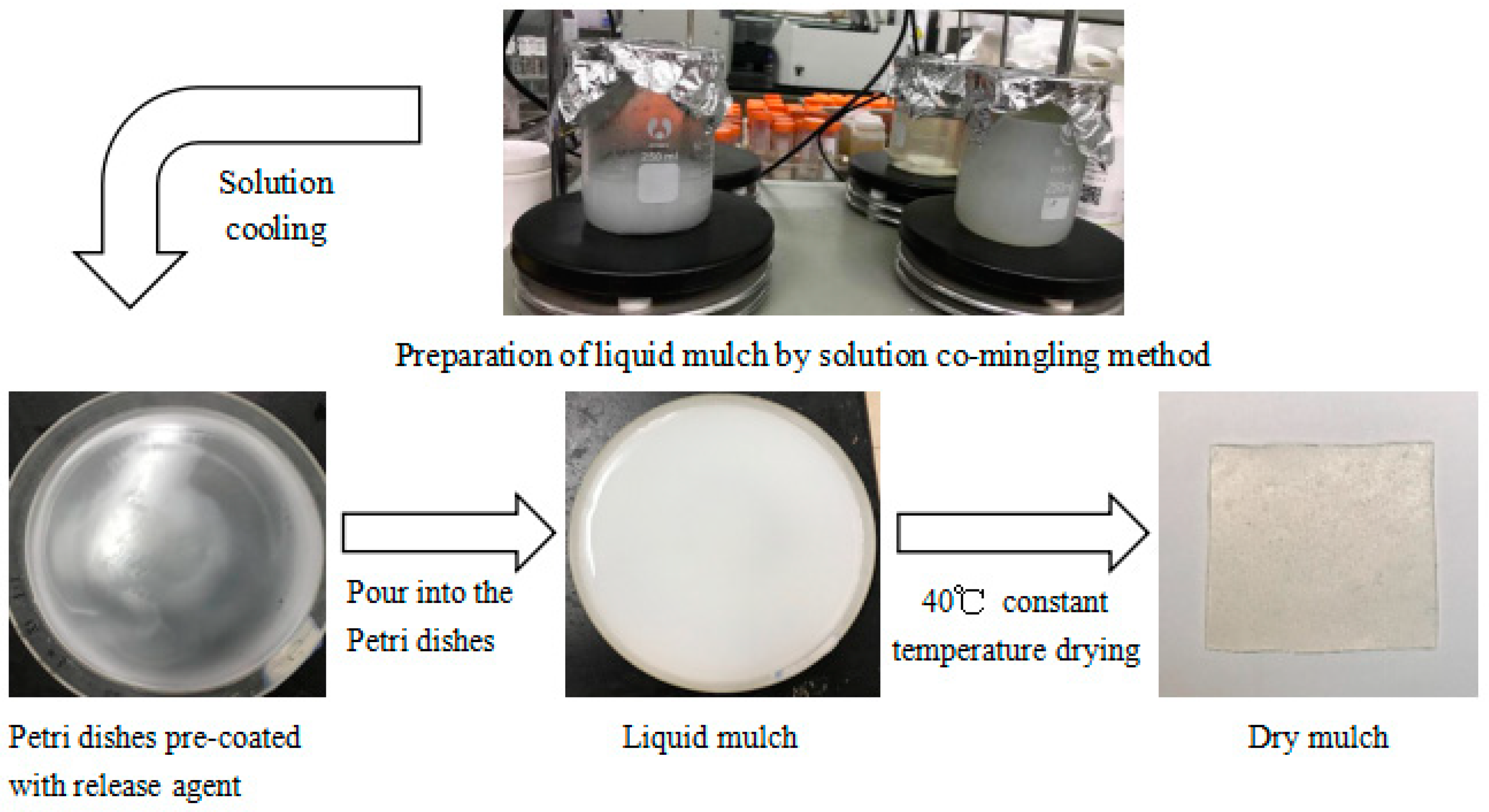
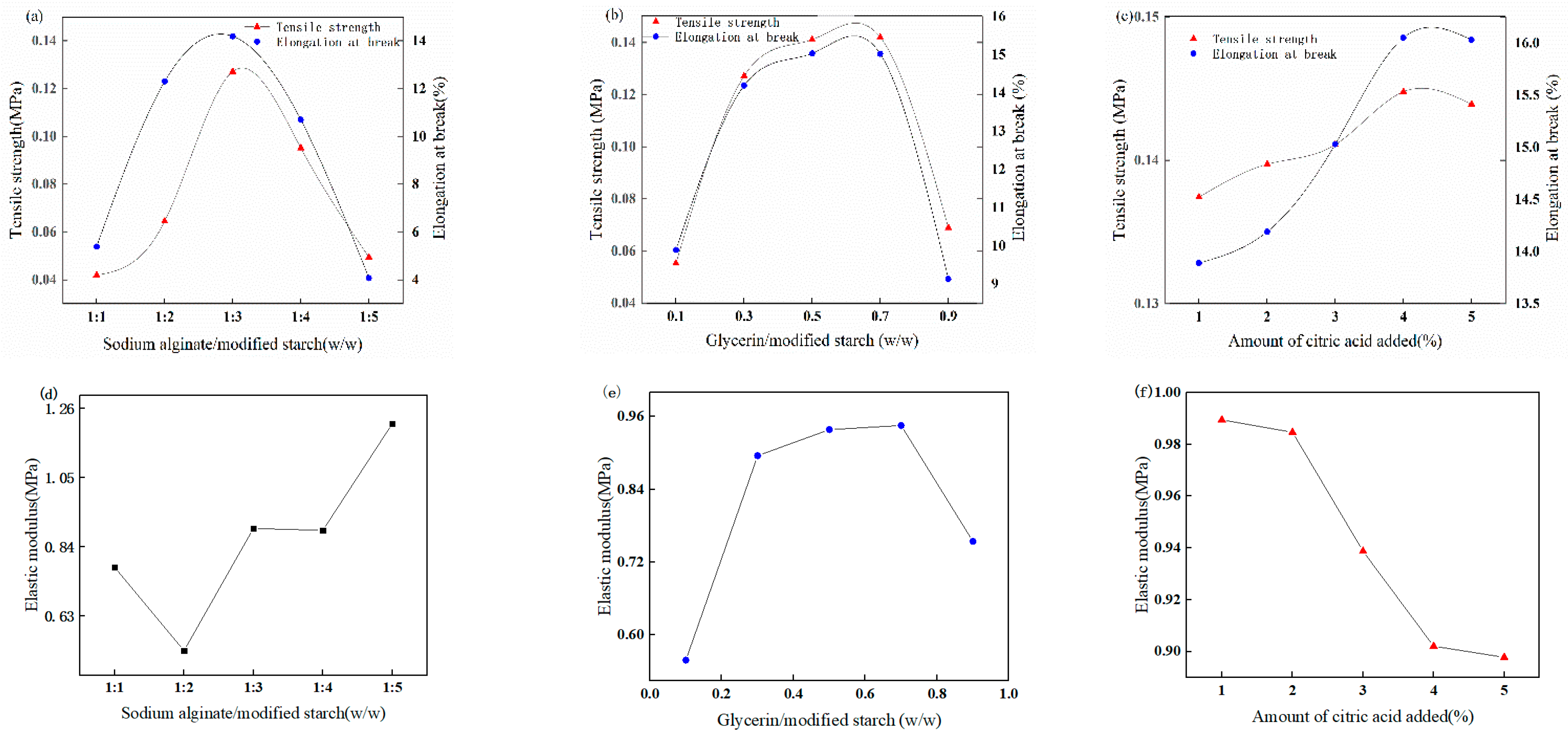
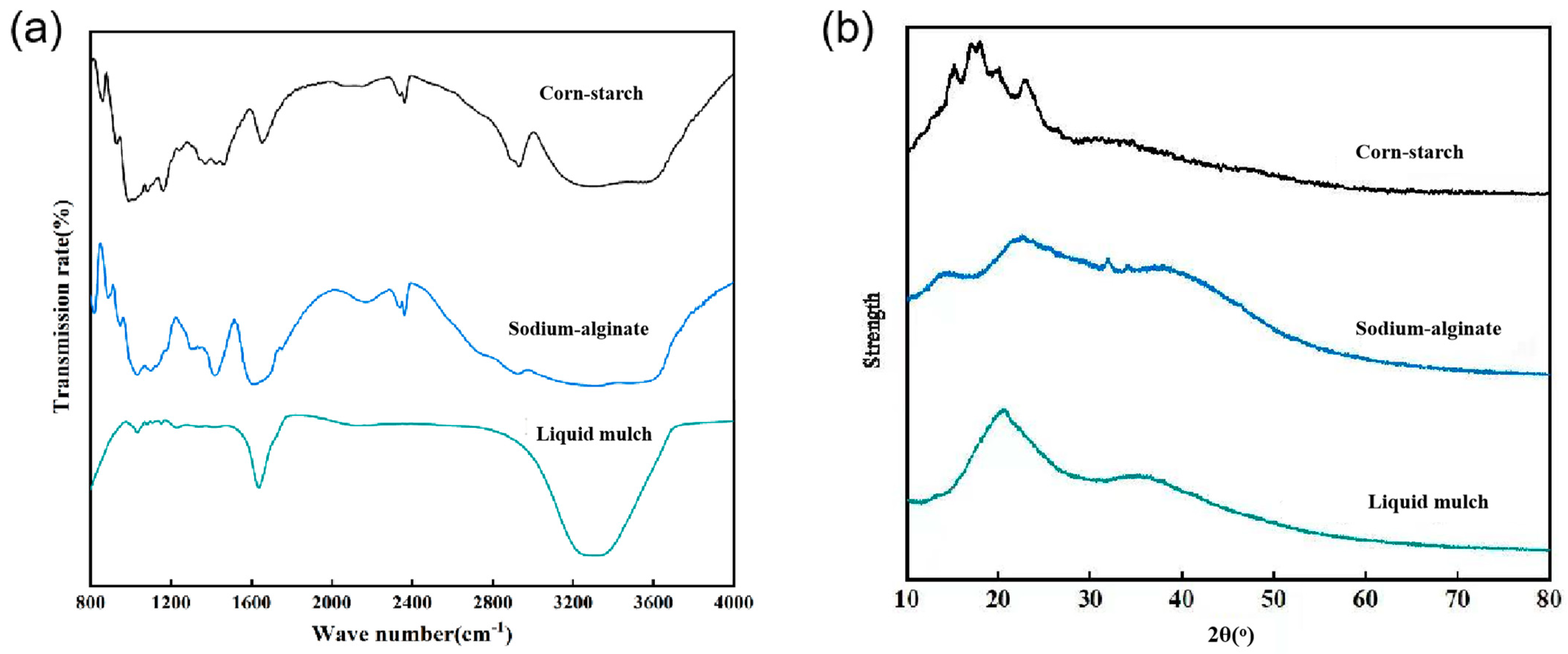
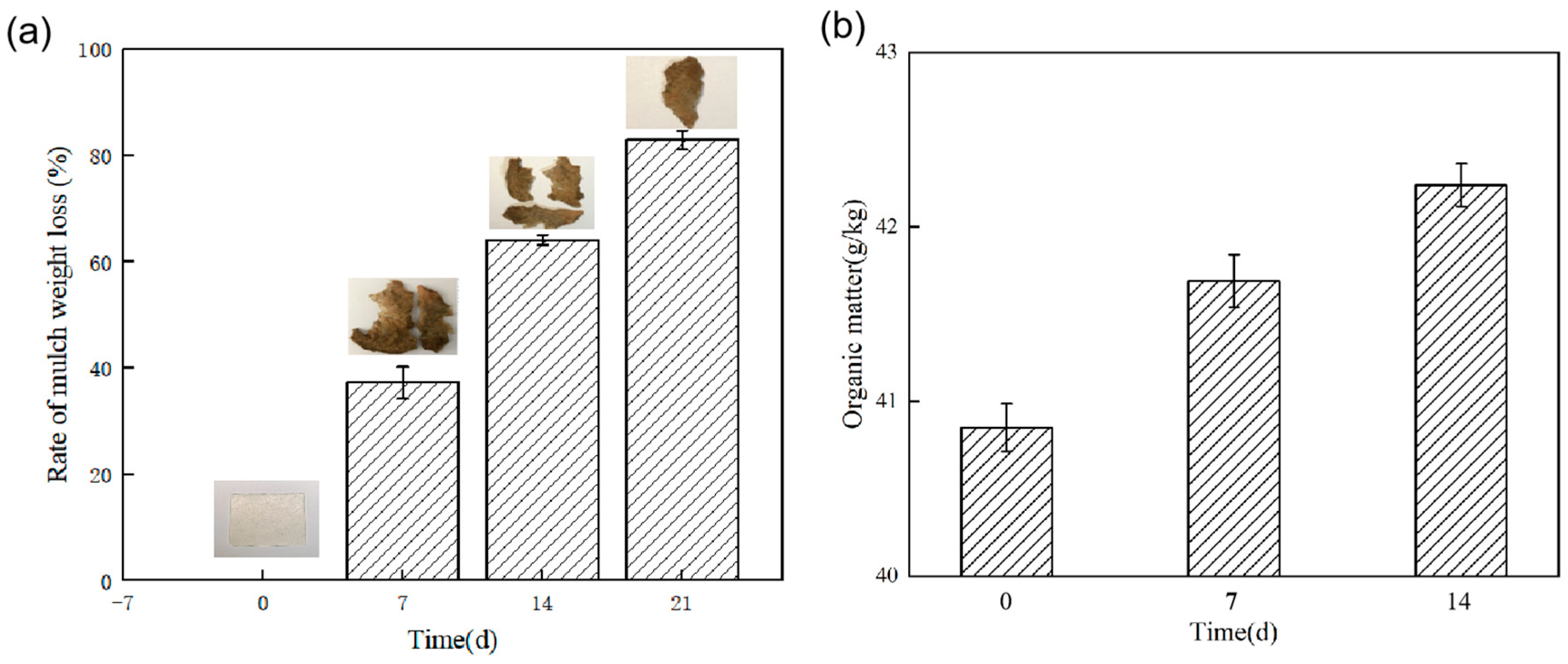
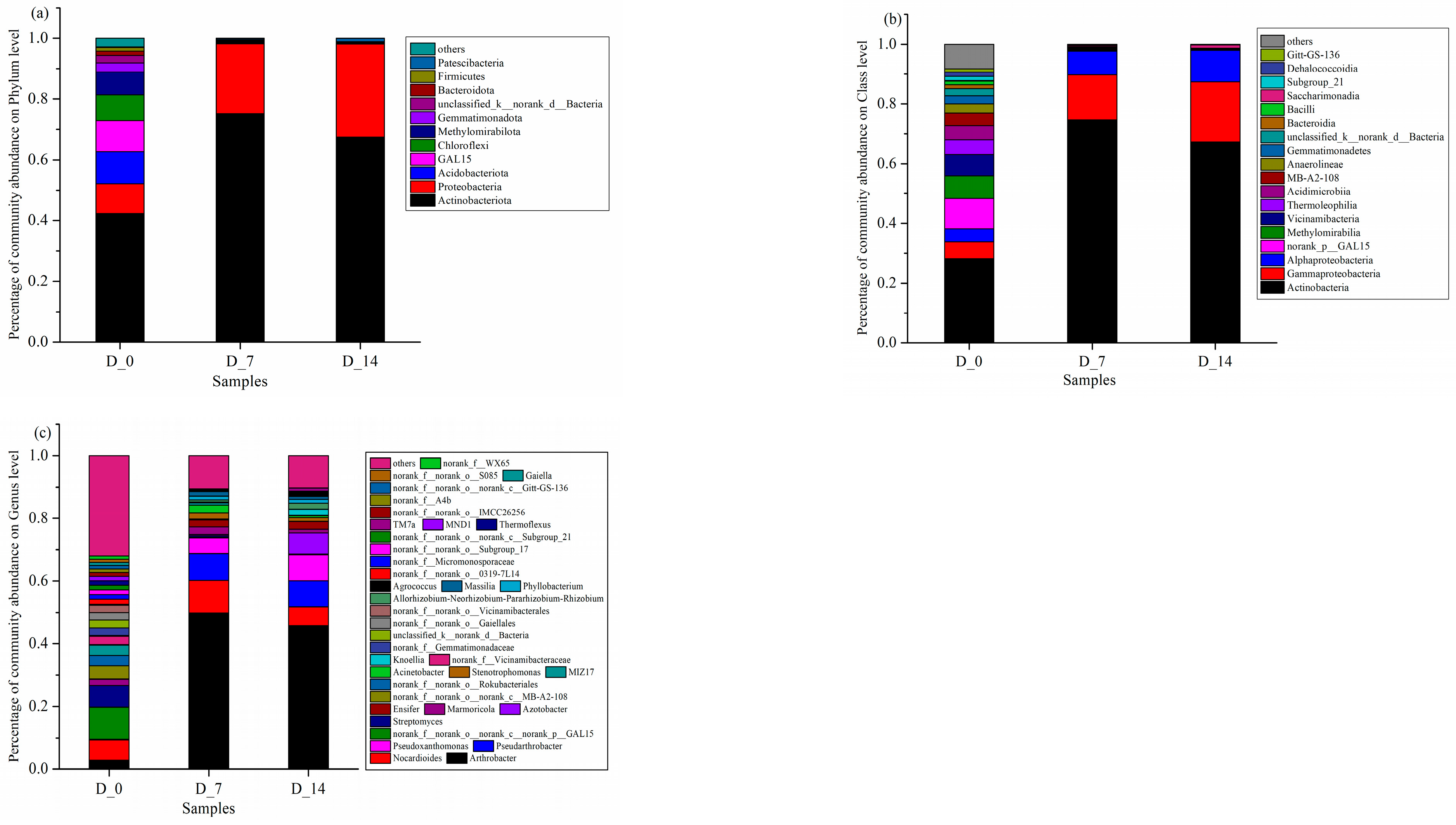

| Factors | Level | ||||
|---|---|---|---|---|---|
| Modified starch with sodium alginate/Quality ratio | 1:1 | 2:1 | 3:1 | 4:1 | 5:1 |
| Glycerol with sodium alginate/Quality ratio | 0.1 | 0.3 | 0.5 | 0.7 | 0.9 |
| Amount of citric acid added/% | 1 | 2 | 3 | 4 | 5 |
| Element | Mass Ration (%) | Atomic Ratio (%) |
|---|---|---|
| C | 58.09 | 64.94 |
| O | 41.43 | 34.78 |
| Na | 0.48 | 0.28 |
| Total | 100 | 100 |
| Microbial Species | Degradation Time/d | Valid Sequences | Shannon | Simpson | Ace | Chao | Coverage |
|---|---|---|---|---|---|---|---|
| Bacteria | 0 | 48,730 | 5.43 | 0.01 | 1050.51 | 1048.71 | 1.000 |
| 7 | 46,208 | 2.56 | 0.26 | 551.02 | 522.07 | 0.997 | |
| 14 | 51,305 | 2.59 | 0.23 | 536.63 | 441.73 | 0.997 | |
| Fungi | 0 | 39,446 | 2.64 | 0.22 | 130.17 | 130.00 | 1.000 |
| 7 | 45,023 | 2.57 | 0.15 | 149.41 | 150.63 | 1.000 | |
| 14 | 71,212 | 2.56 | 0.14 | 172.83 | 168.77 | 1.000 |
Publisher’s Note: MDPI stays neutral with regard to jurisdictional claims in published maps and institutional affiliations. |
© 2022 by the authors. Licensee MDPI, Basel, Switzerland. This article is an open access article distributed under the terms and conditions of the Creative Commons Attribution (CC BY) license (https://creativecommons.org/licenses/by/4.0/).
Share and Cite
Gao, X.; Fu, C.; Li, M.; Qi, X.; Jia, X. Effects of Biodegradation of Corn-Starch–Sodium-Alginate-Based Liquid Mulch Film on Soil Microbial Functions. Int. J. Environ. Res. Public Health 2022, 19, 8631. https://doi.org/10.3390/ijerph19148631
Gao X, Fu C, Li M, Qi X, Jia X. Effects of Biodegradation of Corn-Starch–Sodium-Alginate-Based Liquid Mulch Film on Soil Microbial Functions. International Journal of Environmental Research and Public Health. 2022; 19(14):8631. https://doi.org/10.3390/ijerph19148631
Chicago/Turabian StyleGao, Xia, Chenxing Fu, Mingxiao Li, Xuejiao Qi, and Xuan Jia. 2022. "Effects of Biodegradation of Corn-Starch–Sodium-Alginate-Based Liquid Mulch Film on Soil Microbial Functions" International Journal of Environmental Research and Public Health 19, no. 14: 8631. https://doi.org/10.3390/ijerph19148631





